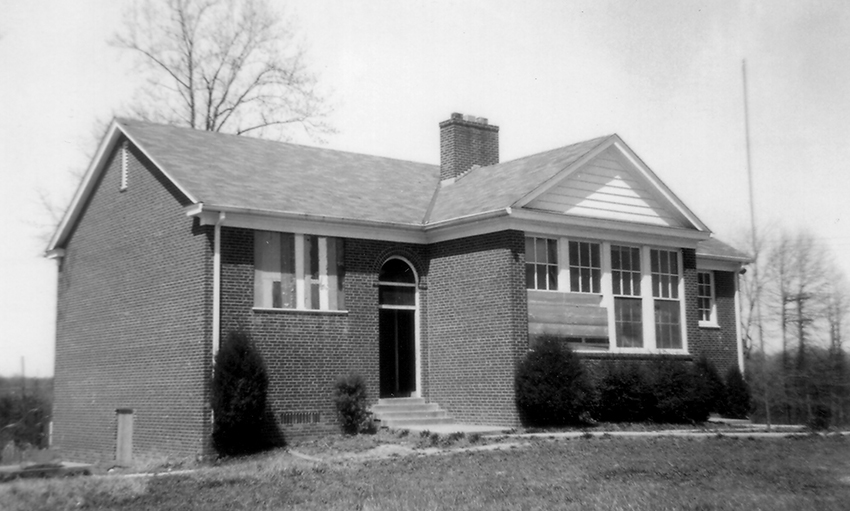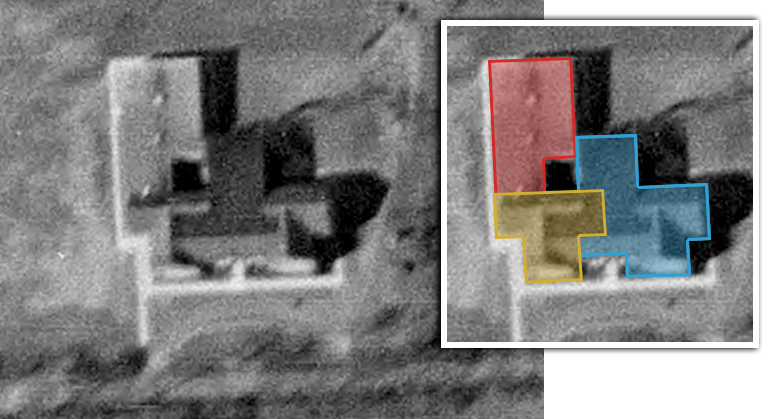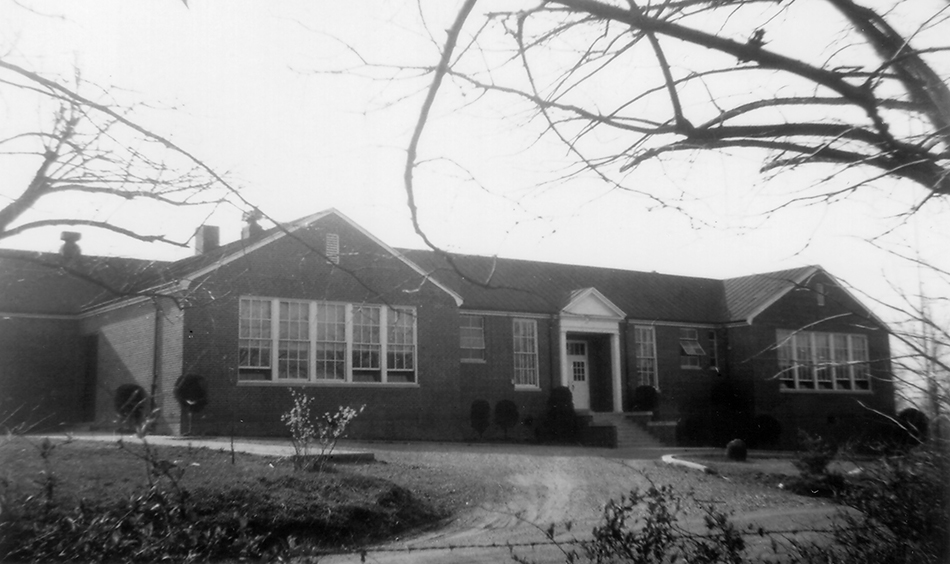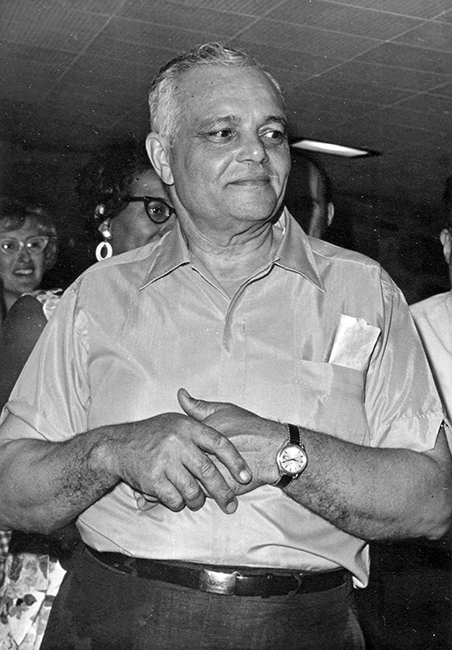Our History (1948-1970)
After the death of long-time principal/teacher Louise R. Archer, teacher Mabel T. Mack was promoted to acting principal for the remainder of the school year. She was succeeded on August 26, 1948, by B. Oswald Robinson, who served as the principal of Louise Archer Elementary School for 22 years. During his time as principal, enrollment in Fairfax County Public Schools (FCPS) increased from 12,118 in June 1949, to 133,362 in September 1970. Yes, you read those numbers correctly.
In September 1948, Bettie Ingram Cooley joined the staff of Louise Archer as a teacher, Primrose Ellis was hired as the secretary to the principal, and Roy Hampton was appointed custodian. Mabel T. Mack and Channie C. Henderson remained on the school’s faculty, and Mr. Robinson, in addition to his duties as principal, served as the sixth and seventh grade teacher. In October, FCPS Superintendent Woodson reported to the School Board that enrollment at the Louise Archer School had increased to 130 students, and he recommended the appointment of an additional teacher. Construction of the first addition to the school, begun in 1947, was completed during the school year. For first time the school had central heating and the students were able to use indoor bathrooms instead of outhouses. The kitchen and cafetorium (a dual-purpose cafeteria/auditorium) opened in the fall, and the students and staff savored fresh-made lunches prepared daily.
Principal B. Oswald Robinson
Bladen Oswald Robinson was born January 8, 1910, in Prince William County, Virginia. He grew up on a farm in Manassas owned by his grandfather. He was named Bladen for his grandfather and Oswald after Oswald Villard, a prominent member of the board of the Manassas Industrial School, which at that time was privately owned and operated as a regional vocational high school for African-American children. Mr. Robinson graduated from the Manassas Industrial School in 1928, and began teaching in the public schools of Prince William County. During the summer months, he studied at Virginia State University in Petersburg, from which he earned his Normal Professional teaching certificate in 1934. In August 1935, he married Adris Lenore Berry in Washington, D.C., and two children were born to the couple in 1938 and 1939. In November 1943, Mr. Robinson enlisted in the U.S. Navy and served until his discharge in 1946 at the Great Lakes Naval Training Station. Upon discharge, Mr. Robinson enrolled at Catholic University in Washington, D.C., and graduated cum laude from the College of Arts and Sciences in June 1948. FCPS Department of Human Resources payroll records indicate Mr. Robinson was appointed principal of Louise Archer Elementary School on August 26, 1948, and retired on June 26, 1970.

The Challenges of Rapid Growth
As early as November 1949, school system officials began planning for a second addition to Louise Archer Elementary School. On November 13, 1949, the Evening Star newspaper reported that plans were underway for a two-classroom addition to the Louise Archer School. However, it took almost four years for the project to come to fruition. A rededication ceremony was held in the school cafetorium on Sunday, April 16, 1950, and, in the winter of 1951, a baby contest and a performance of “A Man of Mystery” were held to raise funds for stage curtains. A cyclorama and stage curtains, jointly funded by the School League and the School Board, were installed in the summer of 1951.
In 1950, Fairfax County voters approved a $10.5 million bond issue to fund numerous school construction projects. Some of those projects included the construction of three new elementary schools for African-American children (Drew-Smith, Eleven Oaks, and Oak Grove), an addition to Louise Archer Elementary, and the construction of the county’s first high school for African-American children (Luther Jackson). However, the sale of the bonds was delayed for one year because of a lawsuit contesting the validity of the bond issue. The plans for the addition to Louise Archer Elementary School were completed by architect Earl B. Bailey in September 1951, but construction was further delayed when the State Board of Education refused to approve the plans because the size of the school lot did not meet their requirements. In fall 1951, FCPS Superintendent Woodson entered into negotiations with the owners of four separate parcels of land around the school. Most of the purchase agreements were finalized by January 1952, but one of the parcels required eminent domain proceedings in the Circuit Court of Fairfax County.
On March 4, 1952, the Fairfax County School Board awarded the construction contract for the addition to Louise Archer Elementary School to Whitener and Skillman, Inc., in the amount of $77,710. The school was expanded to seven classrooms, and a clinic, library, and office were added. In February 1953, after the addition to Louise Archer had been completed, the two-room Odrick’s Corner Colored School was closed and its 74 students were assigned to Louise Archer. Mrs. Ora Robinson Lawson, a teacher at Odrick’s Corner, joined the faculty of Louise Archer and remained on staff until 1965.

After the consolidation of the Odrick’s Corner School with Louise Archer, it became apparent that the kitchen facilities at Louise Archer were inadequate to support the number of children enrolled in the school. In July 1953, the School Board authorized the expansion of the school’s kitchen into a room that had been used for classroom space. The Board also directed school staff to convert the multi-purpose room into a permanent classroom and to utilize the cafeteria for activities that had been conducted in the multi-purpose room.

A Third and Fourth Addition
In 1953-54, Principal B. Oswald Robinson had six full-time teachers on staff: Bettie Cooley, Channie Henderson, Ora Lawson, Mabel Mack, Laura McPhail, and Addie Pleasants. Annie Fortune, a part-time art teacher, periodically visited Louise Archer as she made her rounds among all the African-American schools in the county. In April 1954, Louise Archer Elementary School’s second graders participated in the Salk polio vaccine testing program. Approximately 2,400 second graders in FCPS were inoculated with the polio vaccine during the testing program.

As the baby boom continued, it became apparent that another addition would be needed for Louise Archer Elementary School. In 1956, the School Board began planning for a three-classroom addition to the school. A $3 million bond issue was approved by voters in December of that year, approximately $60,000 of which had been allocated for the Louise Archer addition. The contract for the addition was awarded in January 1957, to Eugene N. Hooper of Falls Church, Virginia, and was completed ahead of schedule in July 1957. The addition increased the capacity of the building by 96 pupils, but skyrocketing enrollment growth in Fairfax County continued to plague FCPS and soon the school became overcrowded again. In June 1958, the architecture firm of Strang and Childers was hired to draft plans for an addition to Louise Archer Elementary School to include three classrooms and an activity room. The project contract was awarded in January 1959 to W. A. Sherman.

Higher Education
From 1939 to 1954, graduates of Louise Archer Elementary School who wanted to continue their education beyond the seventh grade had to travel to Washington, D.C., or to a regional high school in Manassas. The trip to Manassas required a lengthy commute by bus. In this video, former FCPS students describe the bus trip to Manassas.
In September 1954, Fairfax County opened its first, and only, all African-American high school, Luther Jackson in Merrifield. When Luther Jackson opened, African-American children in grades 8-12 were bused from widely scattered communities throughout Fairfax County to Merrifield. In September 1958, in an effort to further reduce overcrowding at elementary schools, seventh graders were sent to Luther Jackson High School as well, reducing the student body at Louise Archer to grades 1-6.
Desegregation
The U.S. Supreme Court’s ruling in the case of Brown v. Board of Education to desegregate public schools was handed down in May 1954, but by the early 1960s change had yet to come to many of Virginia’s public schools. From 1954 to 1959, many elected officials in Virginia actively sought ways to block the racial integration of the public schools in the state. This period of state-level “massive resistance” was eventually struck down in the courts, but local opposition to school desegregation in Virginia persisted in many counties into the 1970s. In Fairfax County, the School Board and Superintendent Woodson began working on a grade-per-year desegregation plan in 1959, but this plan never went into full effect because it was struck down in September 1960 by Judge Bryan of the Federal Court in Alexandria.
The community did not realize what a loss it was taking when it was operating a dual system.
~ Principal B. Oswald Robinson
The racial integration of the public schools of Fairfax County was achieved by the closing of the all-African-American schools and the busing of the children to formerly all-white schools. Beginning in 1960, African-American students were slowly admitted to white schools through a pupil placement application process. In September 1963, the Washington Post reported that only 428 of the county’s 2,529 African-American children had been enrolled in formerly all-white schools. During the 1964-65 school year, under continued legal pressure in the Federal Courts, the School Board and FCPS Superintendent Funderburk drafted a new plan to speed up the process. That plan led to the closure of Oak Grove Elementary School in 1964, the closure of Drew-Smith and Lillian Carey elementary schools in 1965, the closure of Luther Jackson High School and its conversion to an intermediate school in 1965, and the closure of Eleven Oaks and James Lee elementary schools in 1966.
Well, of course, I had read very widely from the daily press from the various cities just what had gone on in the other areas and I had many nights of thought of what might occur here, and there were evidences of it vocally, but when the people of the community came to grips with it, it could not have passed more smoothly than it did and the faculty that came in was the most workable, the most esprit de corps that I have ever worked with.
~ Principal B. Oswald Robinson
Of the six all-African-American elementary schools in Fairfax County at the time of desegregation, only Louise Archer integrated and remained in operation as an elementary school. Significant boundary adjustments were made to several schools in the Vienna area prior to the opening of schools in September 1965.
Going back before integration this particular school drew Negro students from Herndon, Great Falls, Chain Bridge, and Fairfax, a distance of 20-25 miles and it was built right adjoining the white schools so that when we drew – or when the lines were drawn – you were drawing the lines for a school within a school boundary so that the lines are very irregular and at the same time in drawing these lines the proportion of Negroes living in Vienna were divided among several schools, Vienna Elementary, Flint Hill, and Marshall Road. So that each of the schools have a portion of the Negro community.
~ Principal B. Oswald Robinson
Louise Archer students who lived outside of Vienna were assigned to Churchill Road, Dunn Loring, Franklin Sherman, Herndon, Great Falls, and Spring Hill elementary schools.
Where Did They Go?
When Louise Archer Elementary School integrated in 1965-66, nearly all of the school’s faculty were reassigned to other schools in Fairfax County. The one exception was B. Oswald Robinson, who continued serving as the school’s principal.
The teachers who were here before 1965, each was moved into a school within the county. No one, and I repeat, no one was denied a job. No one received a lesser job than one was doing here. And I will also state that those who were doing a good job as teachers here did and are still doing a good job at the schools to which they have gone. I have talked with most of the principals in these schools and they are saying that each of these persons has been a real asset to that faculty.
~ Principal B. Oswald Robinson
The following is a list of teachers known to be at Louise Archer prior to desegregation and the names of the schools to which they were assigned in 1965-66.
| Teacher | Assigned School | Year |
|---|---|---|
| Ruth Sommersette Branch | Vienna Elementary | 1965-66 |
| Mary Alexander Cox | Bailey’s Elementary | 1965-66 |
| Channie A. Catlett Henderson | Oakton Elementary | 1964-65 |
| Ora Christian Robinson Lawson | Haycock Elementary | 1965-66 |
| Anna Elaine Lightfoot | Stenwood Elementary | 1965-66 |
| Mabel B. Thomas Mack | Keene Mill Elementary | 1965-66 |
| Ida Wright Murchison | Fairfax Villa Elementary | 1965-66 |
| Addie Belle Greene Pleasants | Eleven Oaks Elementary | 1965-66 |
| Ruth Singletary Robinson | Rose Hill Elementary | 1965-66 |
Welcome Kindergarteners
Throughout the 1960s, FCPS continued to experience rapid student-population growth, adding approximately 6,000 – 8,000 additional students every year. From September 1967 to September 1968, the student population jumped from 107,000 to 121,770, but this significant increase was due in large part to the implementation of a new program division-wide. During the 1967-68 school year, a kindergarten program was piloted in several schools. The pilot proved so successful that kindergarten was added in every elementary school the following year. Approximately 8,100 five-year-olds entered FCPS kindergarten classrooms in September 1968.
The esprit de corps with the faculty is superb. Some of the highlights that have gone on in these five years have been the Head Start program, which I thought was the best program offered up until kindergarten became a part of the school system. I think this is so because kindergarten has much more direct association with the administration than did Head Start. Some of the other innovations have been our program with the Madeira School, which school had a great interest in the underprivileged children here. These youngsters have been taken to Madeira on Saturdays, spent the major portion of the day there, including field trips throughout the entire area, classes in art, horseback riding, archery, etc. These youngsters look forward to this with great anticipation.
~ Principal B. Oswald Robinson, 1970 Interview
From 1965 to 1970, enrollment at Louise Archer Elementary School grew steadily from 347 to 486 students. In August 1969, due to the age of the building, Louise Archer was placed on a priority list of elementary schools in need of renewal and modernization. Principal Robinson was heavily involved in the planning process, but he retired from FCPS prior to the start of construction. On June 8, 1970, at a special school assembly, the Louise Archer Elementary School library was dedicated the B. Oswald Robinson Library in his honor.

Now if our education, if education means anything to us at all, it means just these two phrases – to know the world and love the world and the people around it. And I think our education now – education in Fairfax – has just about everything to offer in all areas that I expect would be offered to my youngsters if they were youngsters coming through school at the present day… I think education in Fairfax is wonderful.
~ Principal B. Oswald Robinson

